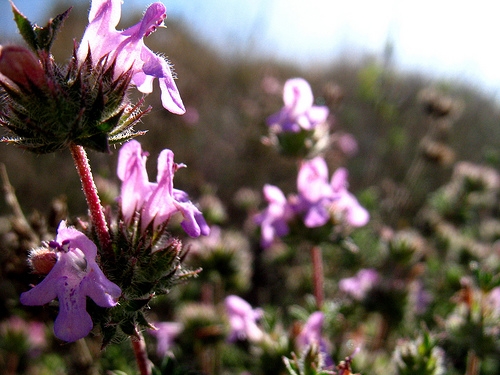Posts Tagged: herbs
Herbs and Mystery
Do you like reading about herbs, even those you don’t use for cooking? Do you also like mysteries, you know – the “who done it” kind. Then I have the book(s) for you!
Susan Wittig Albert has written a series of mysteries featuring a character by the name of China Bayles. Each of these books has an herb in the title such as “Rueful Death” or “Lavender Lies”. I think you get the idea. But! In each of the books, the reader gets a good mystery, recipes using the featured herb – both in cooking and in lotions and in other ways. Set in the fictional town of Pecan Springs in the Texas Hill country, the heroine who just happens to own and operate a shop called Thyme and Seasons, selling dry herbs, fresh herbs, various oils and seasons combinations as well as jams, jellies, and various pestos.
In the “Lavender Lies”, the reader is treated to several recipes using lavender in cookies, iced teas and fruit juices, as well as historical uses of that herb. Did you ever think to drink hot lavender tea? In 1609, an herbalist named John Parkinson wrote a book Paradisi in Sole Paradisus Terrestris in which he wrote, "Lavender has an especially good use for all griefes and paines of the head and brain.” Also there is mention of bugloss (Alkanna tinctoria) used to dye wool and also women’s faces. The deep red color was long lasting and became a symbol of falsehood and deceit; the thought being that a woman who tinted her face could hardly be trusted to tell the truth. I wonder what the make-up folks would make of that idea??
Another tidbit of herbal lore in these books includes mention of a tree growing farther south in Arkansas and Texas called the toothache tree. Actually Zanthoxylum clavaherculis, this tree has bumpy bark is hot to taste and will help a toothache. I got so involve in so of the herbal remedies that I followed in my herb books.
Did you know cacti can be classified as herbs? In books of herbal lore, people have planted cacti to guard the house (no kidding!), but put the spines into a jar w/ rue and rosemary leaves and add rusty nails and tacks and then bury under your doorstep – you now have a powerful protective device to protect the house and contents!! Not to mention that the fruits of the “prickly pear” Opuntia ssp. make a delicious jam, jelly or salsa.
I’ve so enjoyed reading these well-written books packed with mystery, recipes and information about plants which I never would have considered to be “herbs” as well as plants and their parts which come to mind when the word “herb” is mentioned. It is amazing how the author combines all of these details in a “oh, by the way” style.
Savor the Za'atar
What is this mysterious ingredient that Michael Symon and other Iron Chefs are talking about when they refer to Za'atar. I am usually watching the foodie shows in the evening and the question soon fades away only to resurface another evening when a Mediterranean dish is being prepared. By happenstance I recently attended a plant sale and spied an herb marked "Za'atar". Ok, finally I am to find out what the fuss is about with this herb. The plant is labelled Satureja thymbra aka 'Pink Savory Za'atar' of the Laminaceae (mint family) a perennial that grows to 12 " likes sun, is a mid-Eastern spice with the delicious flavor of oregano, thyme and mint and the plant prefers hot dry areas. Great, I have just the garden space in my new perennial garden. Almost alright, I next go to Google to corroborate this new information. I find confusion with my results, is Za'atar an herb as mine was labelled, or is it a spice mixture similar to a curry mixture?
I find that Za'atar has references both as a spice mixture and an herb. The herb Origanium syriacum appears to be the true za'atar with hyssop, Satureja thymbra, the genus of tender, thyme-like plants (Thymbra spicata, t. capitatus) also referred to as Za'atar. The common denominator with these plants is the aroma of oregano from the chemical carvacrol.. The Za'atar spice blends include oregano or thyme or both. So, as is frequently the case, with too much information I have to make a choice. I am going to stay with my local source and I will grown the herb, Satureja thymbra in my garden and call it Za'atar. This evergreen perennial is native to the Mediterranean and is a dominant plant on the island of Crete. It flowers in the spring with large pink flowers and the bush is highly aromatic and imparts a spicy flavor. Here in zone 9b we are very lucky to share the Mediterranean climate that allows many plants to thrive as perennials with the lovely benefit of year round herb gardens. Maybe, I'll send off a question to Alton Brown on this subject and let him tackle this subject and see how he does.
From Roses to Relaxed- part 2
A couple years later and now we are both retired. We decide to pull out another mow strip in front and put in some nice perennials and herbs. We are now cooking alot more and fresh herbs are always a good idea. The dogs play in the backyard so the herbs were much safer in the front. Also, we were beginning to think it would be nice to have some plants that aren't as attractive to insects and disease as our roses have proven to be. I was spending a lot of time with my Sunset New Western Garden Book looking up rose disease and pest solutions by now and had begun to notice that many perennials had some pretty nice features.
So the middle strip of lawn between the walkway up to the front door and the driveway eventually got dug out. Since our two dogs love their daily walks around the neighborhood and I am the designated dog walker, I am noticing more what is going on with the neighbor's gardens and appreciate what is blooming and doing well or not. Have I mentioned that it is very windy in the front yard as our street faces the Carquinez Strait. There is virtually nothing to slow down the wind so the plants have to be sturdy enough to withstand both the long exposure to sun and frequent day long winds. These same winds, I suspect, have also played a role in spreading some of our most prevelent rose diseases and pests amongst our neighbors, namely rust, black spot, mildew and the most invasive of all, the aphids. Thank you perennials for entering our lives.
As we planted our newly dug out mow strip, just by luck did we choose a Lantana montevidensis 'Confetti' to anchor this garden area. I can't claim to have studied a book or website to make this decision. The Lantana was just sitting very prettily near the entrance to Mid-City Nursery the day I had chosen to make some plant purchases. This plant has proven to be one of the hardiest and most prolific bloomers in the garden. It has stood up to my trimming and shaping with a vengence. It has become a real stunner as it is now shaped as a small bushy tree with branches that bend gracefully with many blooms. Besides the many people that like this plant, it has attracted Monarch butterflies each year along with bees and many different birds that are attracted by the berries in late summer. We have added many herbs including Origanium vulgare, Salvia officianalis, and Thymus vulgaris. Besides the herbs, we have added Aloe attenuata and arborescens, Coreopsis, and many, many different succulents. This old mow strip has really turned into a joyful garden.
So with success brings confidence. As we shape our gardens we continue to learn what grows well, and looks good. and when it is time to shovel prune an intruder or poor student as in the case of many of those early rose choices. Truthfully we haven't had to shovel prune much, we have grateful neighbors with more patience and know how who have been happy to give new homes to our cast-offs.




